Myth: Testosterone makes transgender people aggressive and violent.
The L Word/Showtime
"The L Word," which premiered in 2004, was the first-ever series featuring lesbians on mainstream television. Though its existence was a historic step in LGBTQ representation, it wasn't without its problems.
Max Sweeney was the first-ever recurring transmasculine character on a TV series, but the way he was portrayed was extremely troublesome to trans people and allies.
"As someone who was transitioning during the time of the. show that was problematic for me because 'The L Word' is a lesbian show," actor Brian Michael Smith said in "Disclosure." "So they're looking at trans people through a lesbian lense."
As soon as Max begins taking testosterone, a hormone commonly prescribed in gender-affirming treatments, he turns into an aggressive and physically violent person.
Dr. Shirisha Avadhanula, an endocrinologist at Cleveland Clinic, pointed out that a 2019 study published in the National Library of Medicine found there was no correlation between serum testosterone levels and anger intensity in transgender people.
"You notice 'Oh yeah I'm definitely more frustrated,' but to that level?" actor Elliot Fletcher said in "Disclosure." "It paints it in a bad light."
Myth: Hormone replacement therapies like estrogen and testosterone will give you cancer.
Disclosure/Netflix
Another popular trope related to hormones is that HRT kills trans people who take it.
"Disclosure" highlights how in hospital shows featuring transgender characters sick because of their HRT, the trans person on-screen receives the news that they have cancer related to their hormones.
However, a 2019 study published in Endocrinology of Transgender Medicine found that in a study of 2,000 transgender women, there were no higher rates of breast cancer when compared to rates among cisgender women.
While there is a lack of research on the overall cancer risk related to hormone therapy, there is a huge body of data that shows gender-affirming hormones save lives.
"Studies do consistently show, however, that gender-affirming therapy reduces perceived
stress, depression, and anxiety," Avadhanula told Insider.
"People don't die from their life-saving alternatives to the gender containers they've been assigned," Billings said.
Myth: Transgender people aren't whole until they get 'the surgery.'
Crystal Cox/Business Insider
"The Surgery" is one of the first things that comes to mind when thinking of popular representations of transgender people in media.
Whether it's a fixation on the hormones trans people take, the surgical procedures trans people have chosen to have or not have, or simply whether trans people look "real," television show hosts like Katie Couric, Oprah Winfrey, and Phil Donahue have all asked invasive questions to transgender people over the years.
"The preoccupation with transition and surgery objectifies trans people, and then we don't get to really deal with the lived experiences," actress, producer, and trans rights activist Laverne Cox said in a 2014 interview with Couric.
Myth: Most transwomen and femmes are sex workers.
The 40-Year-Old Virgin/Apatow Productions
"I've been Prostitute, Prostitute 1, Prostitute 2, Call Girl, Hooker, but at the same time, I felt limited. I felt like okay, what's next," Jazzmun, an actress, said in "Disclosure," referring to the number of times she was repeatedly cast as a sex worker because she's transgender.
The trope that all transwomen and trans femmes are sex workers is pervasive in popular media.
"GLAAD took a look at 134 episodes of television where a transgender character was brought on just to be a guest star character, and what we found in those portrayals was the most common profession shown for a transgender character was sex worker," Nick Adams, GLAAD director of trans media & representation, said in the film.
These tropes stems from how sex work is demonized in media and the fact that many trans femmes have been pushed into sex work because of a lack of workplace protections for transgender people and subsequent employment discrimination.
Myth: Transgender women and femmes are deranged serial killers.
Buffalo Bill was a serial killer character in "Silence of the Lambs" who skinned his female victims to wear their bodies.
Silence of the Lambs/Orion Pictures Corporation
Films like "Silence of the Lambs," "Dressed to Kill," and many works by Alfred Hitchcock all paint transgender women to be violent.
"For decades, Hollywood has taught audiences how to react to trans people," Adams said in "Disclosure."
"And sometimes they're being taught that the way to react to us is fear, that we're dangerous, that we're psychopaths, that we're serial killers that we must be deviants or perverts. 'Why else would you wear a dress if you're a man.'"
While these movies portray men dressed as women as slashers, stalkers, and other types of criminals, they put forward the false idea that gender nonconformity — trans-feminine gender variance in particular — leads to a thirst for blood.
Myth: Transgender people are just playing dress-up.
John Travolta in "Hairspray."
New Line Cinema






